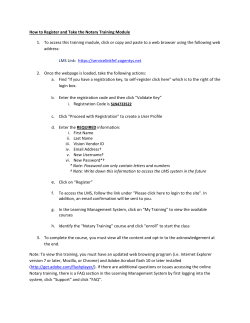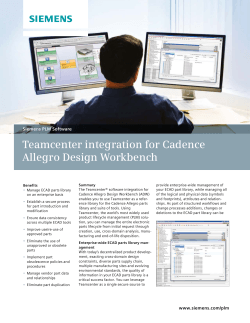
LMS Imagine.Lab Integration
Siemens PLM Software LMS Imagine.Lab Integration Accelerating product development by enabling architecture-driven, model-based design Benefits • Accelerate development by enabling an architecturedriven, model-based design process • Improve product quality by ensuring the integrity of models and simulation results • Increase productivity by managing, finding and re-using validated models • Demonstrate achievement of product requirements and performance targets by establishing Requirements, Functional, Logical and Physical (RFLP) traceability • Decrease warranty costs by enabling engineers to understand the impact of changes Summary The integration of Teamcenter® software with LMS Imagine.Lab Amesim™ software and LMS Imagine.Lab Systems Synthesis software enables engineers to intelligently manage, find, configure and re-use the multiphysics and controls behavioral models and simulation results on an enterprise-wide basis. By leveraging a product’s architectural model definition created in Teamcenter, developers can quickly and accurately find, associate and re-use the models and product configurations needed to investigate and validate a wider range of design alternatives against all product requirements and performance targets. Multi-domain simulation The LMS Imagine.Lab platform includes LMS Amesim and LMS System Synthesis. LMS Amesim provides multi-domain, multilevel mechatronic system modeling, simulation and performance analysis. By assembling predefined and validated components from different domain libraries, you can create the multi-domain simulation models needed to analyze design options and balance the product’s performance according to various attributes. The LMS System Synthesis module helps you configure and integrate physical and control models from LMS Amesim and other authoring applications, such as Simulink®, into a logical view of the entire system for the simulation and co-simulation processes needed to achieve and validate performance requirements. This early model generation and simulation allows design and engineering teams to intelligently balance and verify product performance according to various targets before committing to expensive and time-consuming prototyping and testing. Systems-driven product development Teamcenter supports an architecturebased, systems-driven approach to product development that combines requirements management, systems engineering, physical design and closed-loop modeling with an integrated product definition that enables you to understand and manage all www.siemens.com/teamcenter TEAMCENTER LMS Imagine.Lab Integration Benefits continued • Reduce rework by incorporating models, data and processes in release and change management processes • Develop better products by managing simulation configurations for what-if analyses Features • Manage models and simulation results in a single, secure logical source • Provide support for LMS Amesim and LMS Systems Synthesis for multi-domain, multiphysics modeling and simulation • Versioning, branching and merging support for concurrent model design • Intuitive search and retrieval of models and simulation results • Combine LMS Amesim and Simulink models with functional mock-up units in LMS System Synthesis for co-simulation • Collaborative workflows and structure change processes • Cross-domain RFLP traceability • Product, model and simulation configuration and variant management the complex data, dependencies and relationships. Teamcenter brings all of this knowledge together into a single location where it can be delivered to anyone making a decision at any point in the process. Core components of this approach are Teamcenter systems engineering for architectural modeling and LMS Imagine.Lab for 1D behavioral modeling and simulation. enables you to use Teamcenter to manage all of your 1D behavioral data and relationships from LMS Imagine.Lab and other simulation tools. Using Teamcenter, you can capture, manage, find and re-use all of the models, as well as the verification and validation test data, in conjunction with the rest of the cross-domain components of your product. By integrating models created in the LMS Imagine.Lab environment with Teamcenter, engineers are able to define the simulation architecture and create behavioral models in LMS Imagine.Lab that are linked to finegrain design elements associated with product requirements and performance targets that can be continuously tracked, updated and verified throughout the product lifecycle. Single source of validated model data In many companies, modeling and simulation typically involve tens or hundreds of engineers spread across different locations and disciplines. Each of these groups creates dozens of models stored in multiple repositories spread across several servers, making model management and re-use difficult. As a result, engineers are frequently left with the following challenges: Enterprise model management With complex products, shortened innovation cycles and decentralized product development, it is critical to have enterprise management of your behavioral and architectural models. The integration • Managing model repositories and data • Finding the model they are searching for • Figuring out if it is a valid model • Recording all the changes while building a model TEAMCENTER • Communicating model changes to the right set of users at the right time Using the Teamcenter integration for LMS Imagine.Lab, your modeling and simulation teams can consolidate and organize all of this disparate information into a single location, making it available for use across multiple groups, projects and products. Teamcenter manages all of the models and simulation results as well as the relationships between these objects. As managed objects, models and simulation data can be used in structured workflows and formal change processes. Providing version and change management as well as access controls, Teamcenter ensures that accurate and consistent model information is provided to the right people at the right time. Search, find, share and re-use the right model Engineers not only spend large amounts of time searching for models that may be spread across multiple model libraries and servers, but they also must determine: • Does the model already exist • What are the re-use conditions • Is this the very latest model If they can’t locate the models quickly, they frequently resort to spending days recreating them. Teamcenter provides several ways to find model data. Using the Active Workspace client embedded in LMS Imagine.Lab, you can quickly search the model repositories based upon a host of search criteria including classification name, classification attributes, relationships, validated version, latest version, author name, element name, collection name, publish date and more. Using Teamcenter, engineers are better able to quickly identify and select the right model and its use conditions throughout the design process. Teamcenter enables you to organize and classify system models making it easier to manage, find and re-use them in your model-based systems engineering environment. The classification scheme is user-customizable to best match the needs of your design environment. Engineers can build hierarchies, classes, attributes and valid attribute values into model definitions so that they can quickly locate a particular design element and re-use its related product and process data. Teamcenter support for model traceability and version control helps ensure engineers are accessing the correct version of the model. Leveraging Teamcenter classification, engineers can also create domain or organizational model libraries based upon attributes such as physical object, interface, methods, means usage, validation and verification. The models can be organized in a domain-relevant way, enabling engineers to not only browse and search for the model needed, but also trace to the requirements a model satisfies, the test inputs used for validation, the measurable attribute values associated with the model, and in which simulation context and scenarios the model has been used and validated. By managing and organizing your behavioral models and simulation results, Teamcenter model management and the embedded Active Workspace client help make you more productive and develop higher quality products. Traceability Given the complexity of today’s products, design teams struggle to understand and manage all of the dependencies and relationships between requirements, subsystems and models. They expend much time and effort addressing issues related to determining how to: • Manage model dependencies • Verify that requirements are fulfilled • Validate models for different designs and configuration options These difficulties are further compounded when the inevitable changes are proposed and users must quickly identify, assess and investigate what parts of the product will be affected. By managing your 1D multi-physics and control models in Teamcenter, you can easily link and trace them and their simulation inputs and outputs, test case data, requirements, architecture model and other design objects. Having defined these relationships, the integration also provides a robust set of capabilities to help you view, investigate and understand them. From within Teamcenter, TEAMCENTER or leveraging the Active Workspace client embedded in LMS Imagine.Lab, you can use the relationship or trace matrix browser to graphically highlight and trace dependencies and relationships between objects, such as which models are used for the performance validation of a specific configuration of the product, or which models will be affected if an engineering change is made. The ability to accurately navigate and investigate these relationships is critical to ensuring product quality, especially as the models evolve, product changes are made, or if the models are referenced in multiple products or configurations. Manage and access product configuration Engineers begin the process of system modeling by focusing on the architecture model that contains the system semantics (blocks with a meaning) and interface definitions needed to support various types of simulation downstream. To ensure product quality across variants of the design, they must also select or set the proper configurations for the product. Because there can be thousands of configurations to analyze, time is frequently lost while engineers spend time determining: • How and where to get the product’s architecture • How to set the proper context/product configuration for each product variant • Should the configuration be copied and modeled to simulate another variant Through Teamcenter systems engineering and the Active Workspace client embedded in LMS Imagine.Lab, product and simulation engineers can quickly find the architecture stored in Teamcenter and get the proper product configuration. Additionally, they can navigate to the related product information, find out about the required functionality, and understand the environment and boundary constraints that are key to the creation of the correct model. By leveraging Teamcenter capabilities for managing behavior models, the simulation engineer can quickly find and select the appropriate LMS Amesim models and submodels that are required for co-simulation. The ability to smoothly execute this architecture-driven, model-based configuration verification process helps product teams to simulate, validate and verify how software, electronic and mechanical systems will work together in a complex mechatronic system to meet performance targets. Contact Siemens PLM Software Americas +1 314 264 8499 Europe +44 (0) 1276 413200 Asia-Pacific +852 2230 3308 www.siemens.com/plm © 2014 Siemens Product Lifecycle Management Software Inc. Siemens and the Siemens logo are registered trademarks of Siemens AG. D-Cubed, Femap, Fibersim, Geolus, GO PLM, I-deas, JT, NX, Parasolid, Solid Edge, Syncrofit, Teamcenter and Tecnomatix are trademarks or registered trademarks of Siemens Product Lifecycle Management Software Inc. or its subsidiaries in the United States and in other countries. All other logos, trademarks, registered trademarks or service marks belong to their respective holders. 43683-Y3 11/14 B
© Copyright 2025










